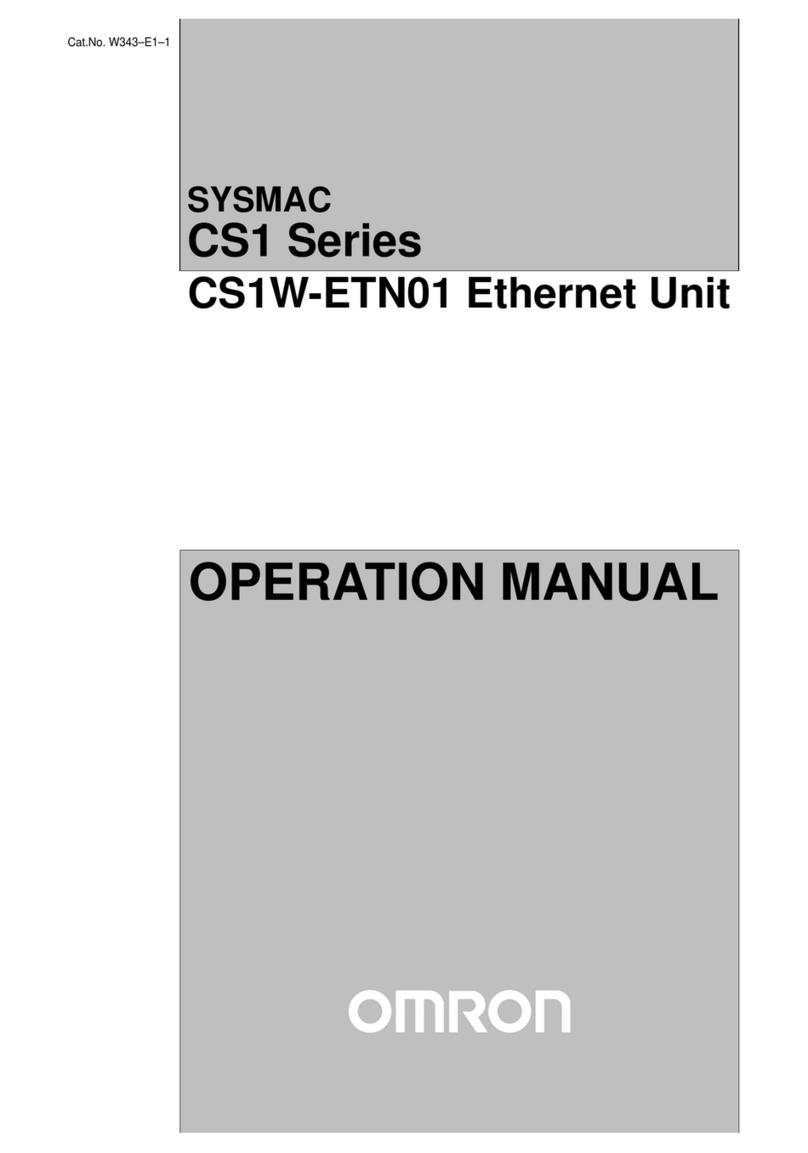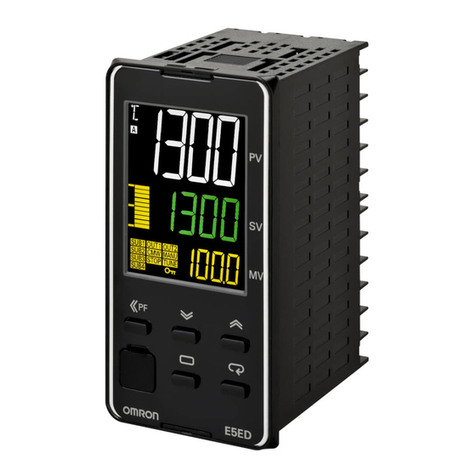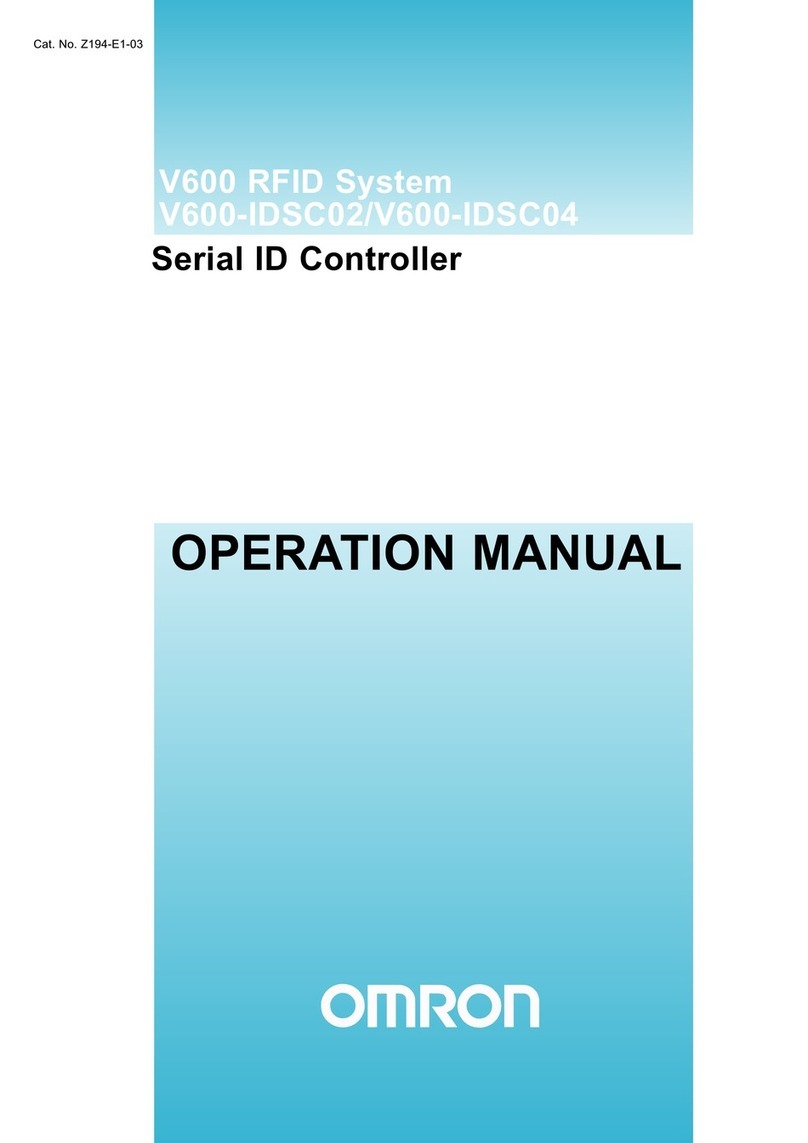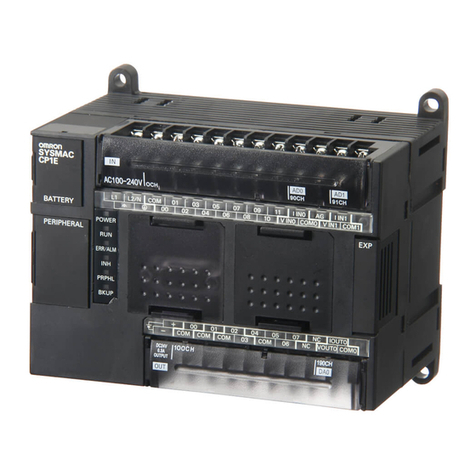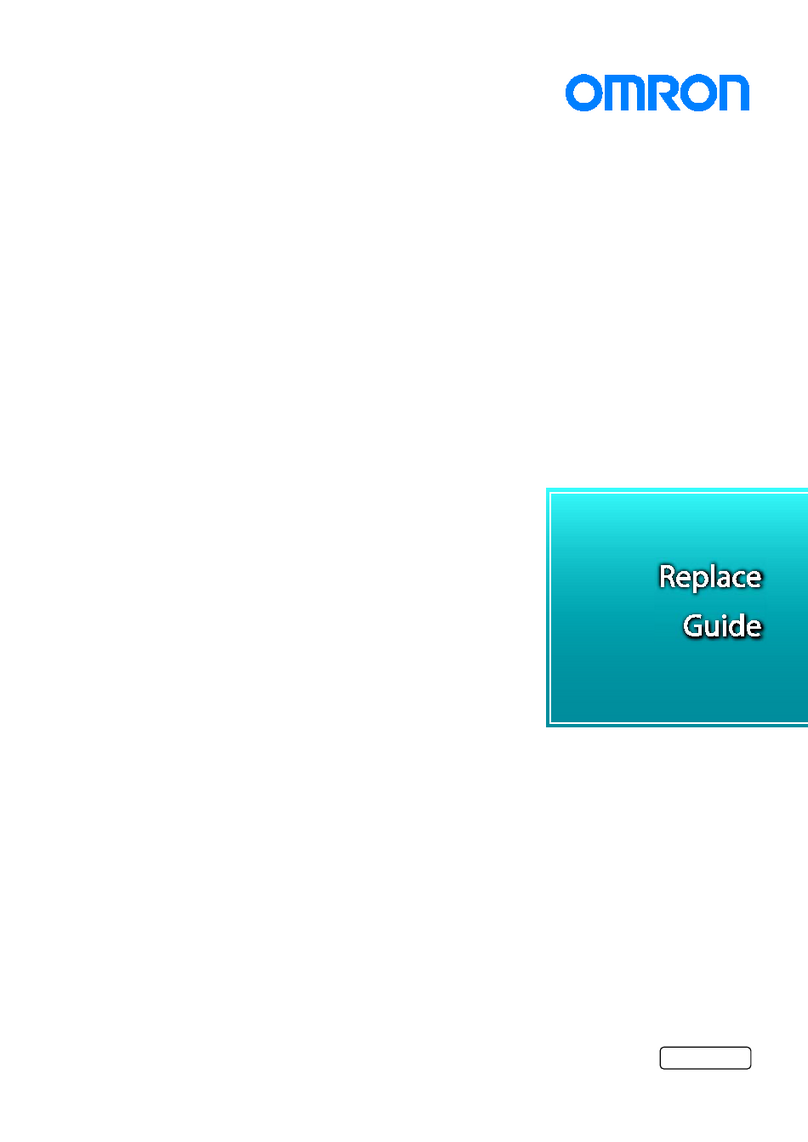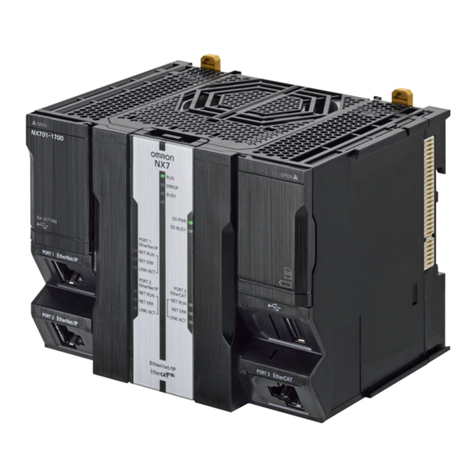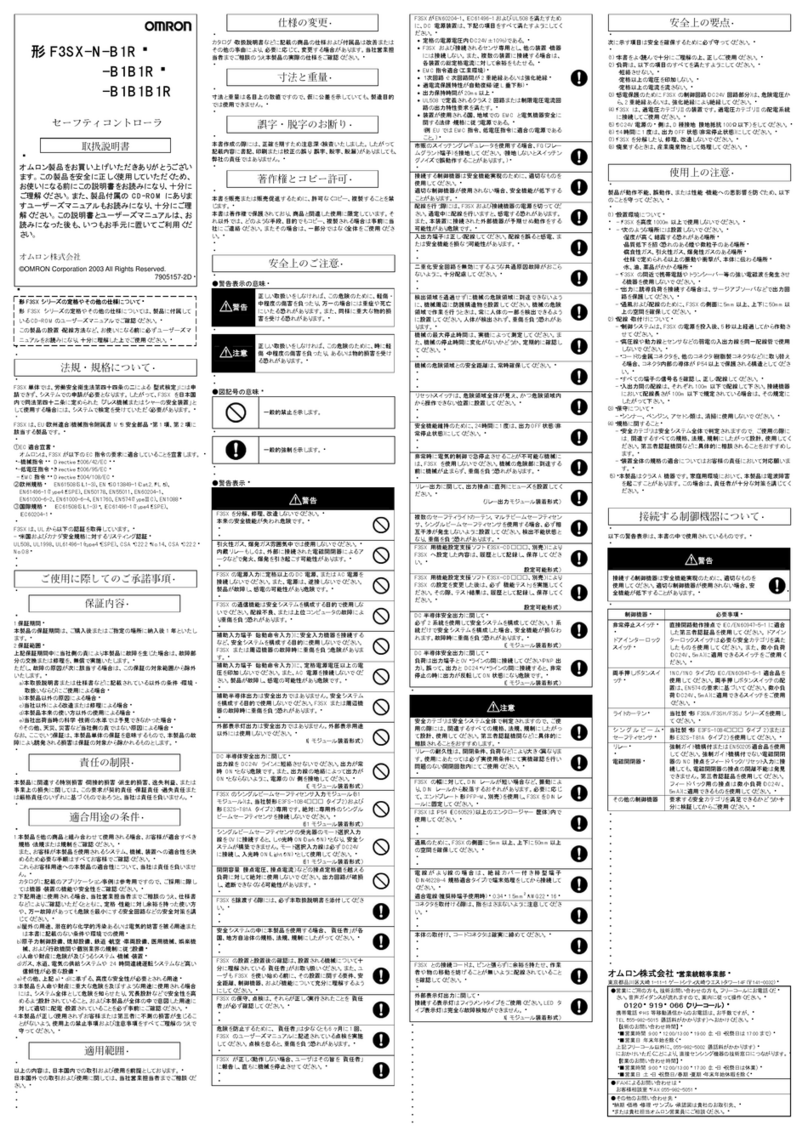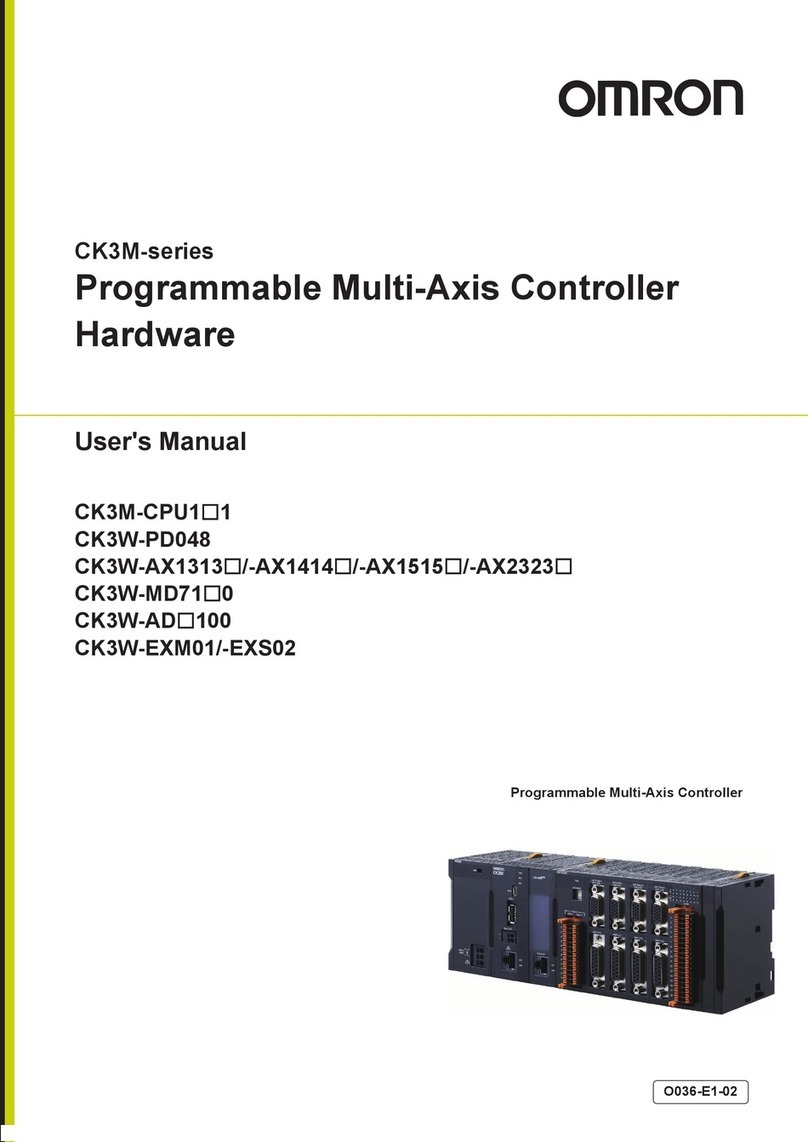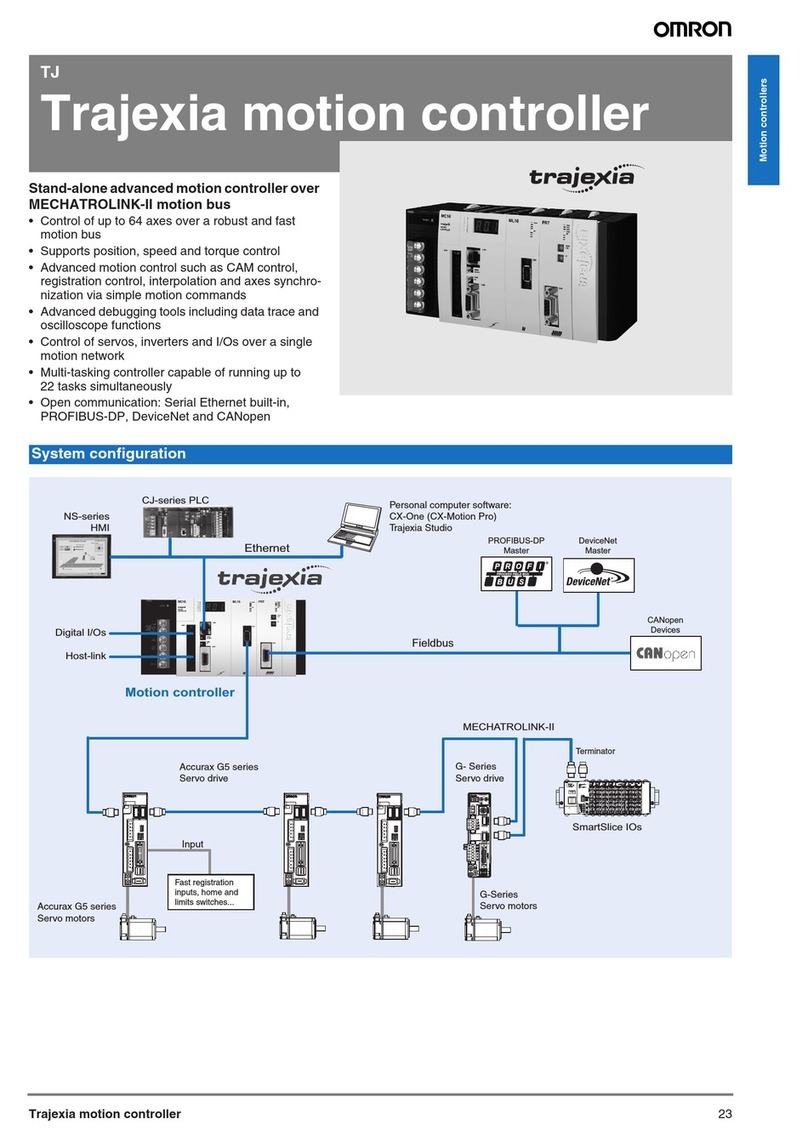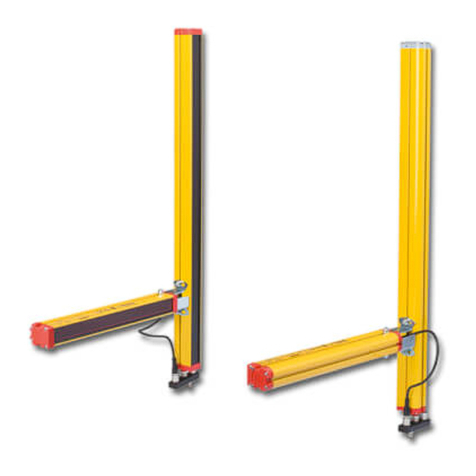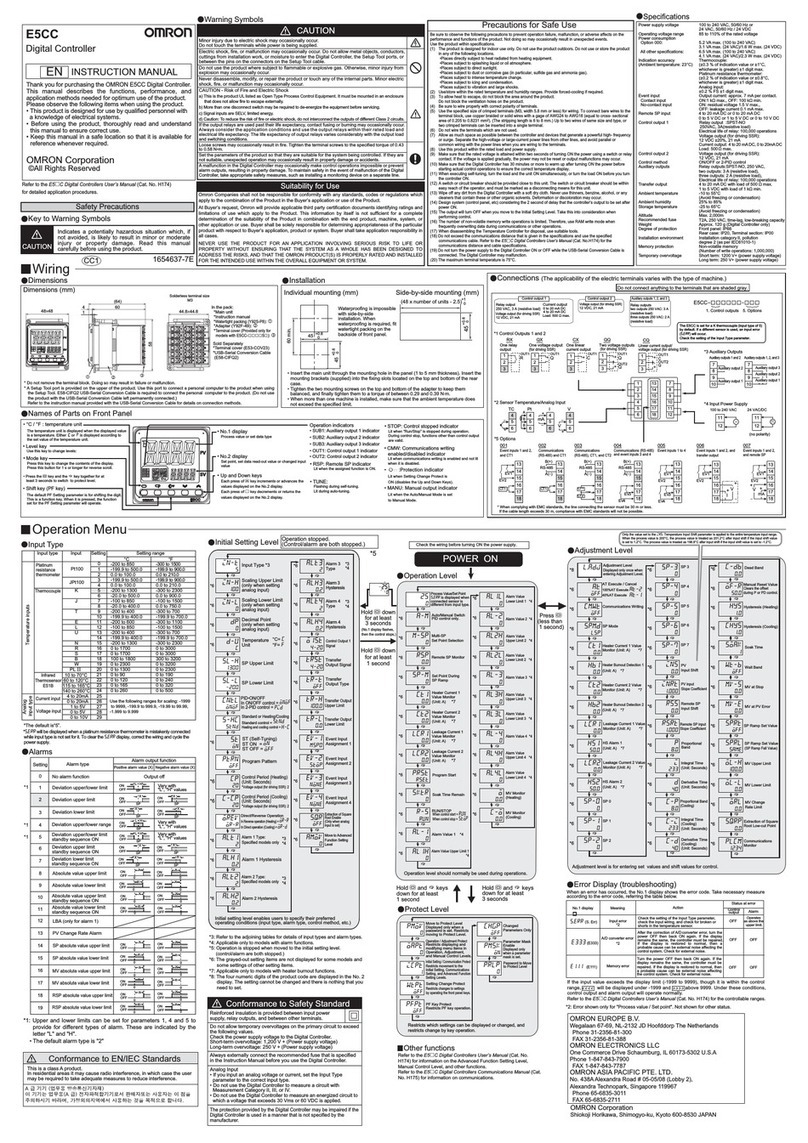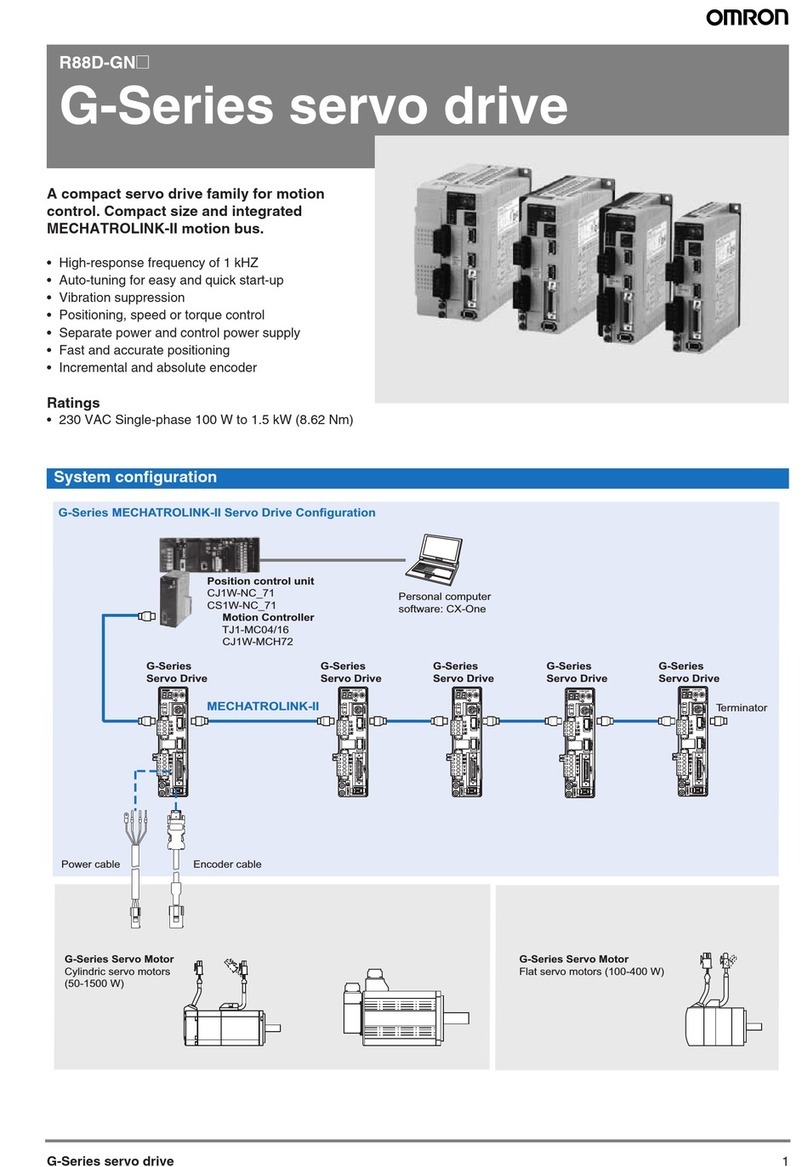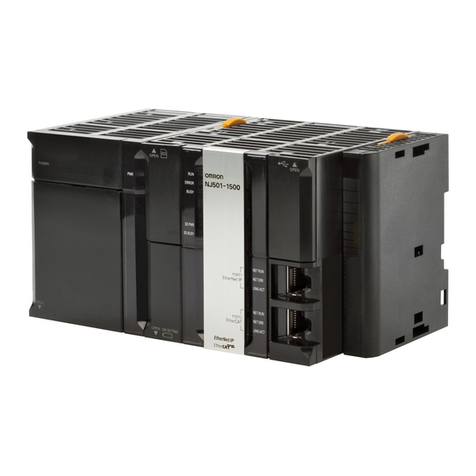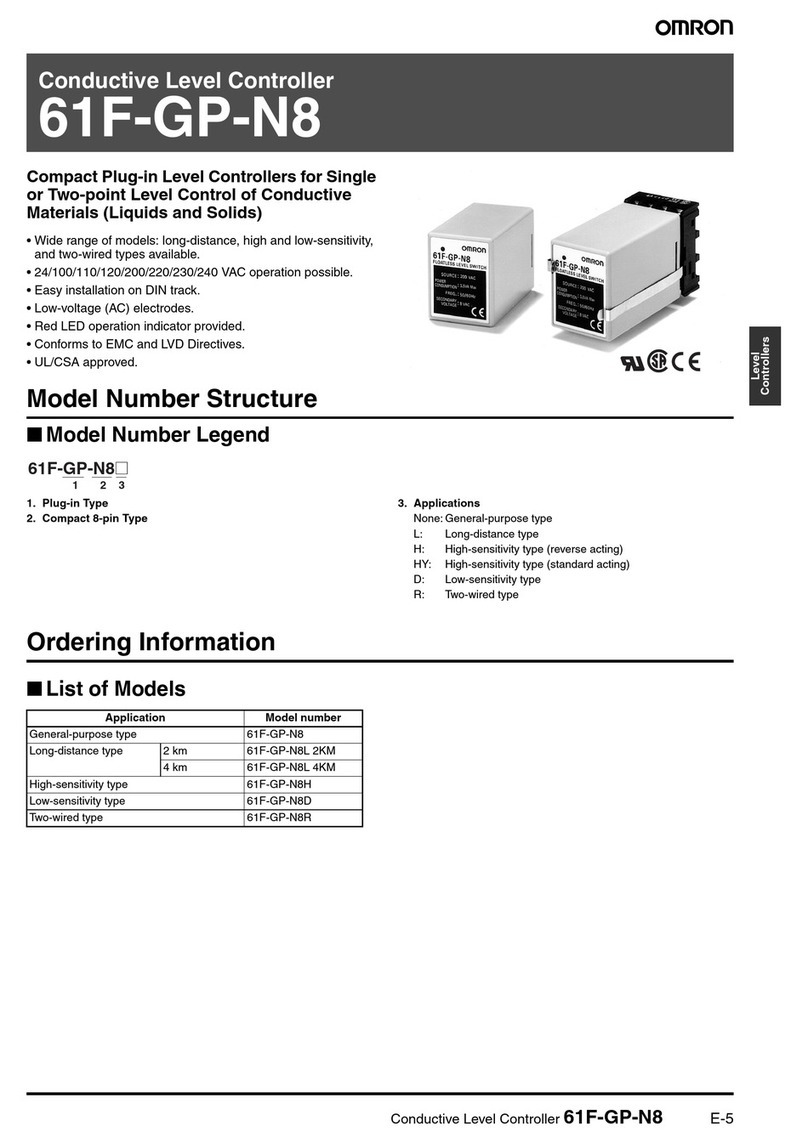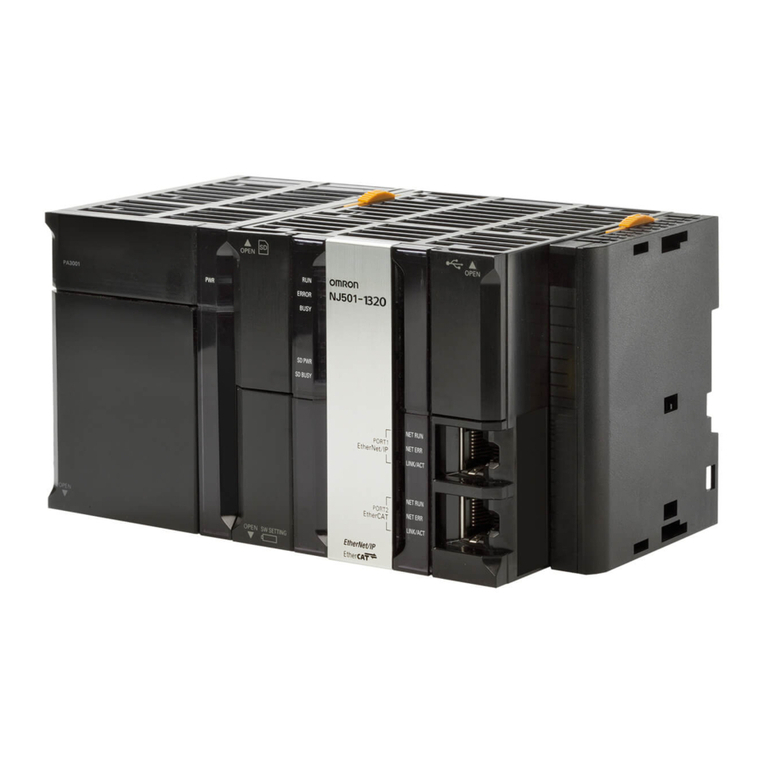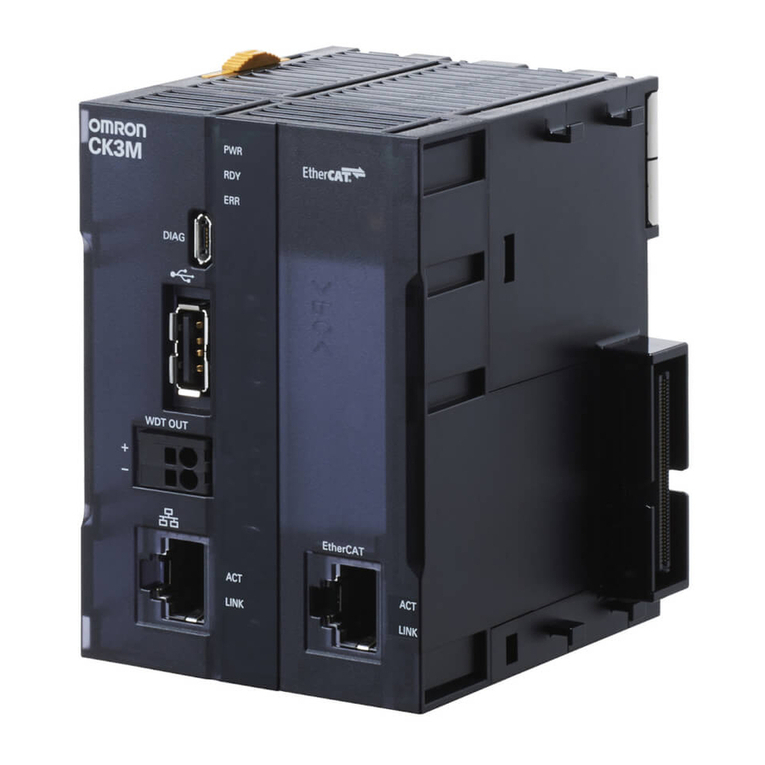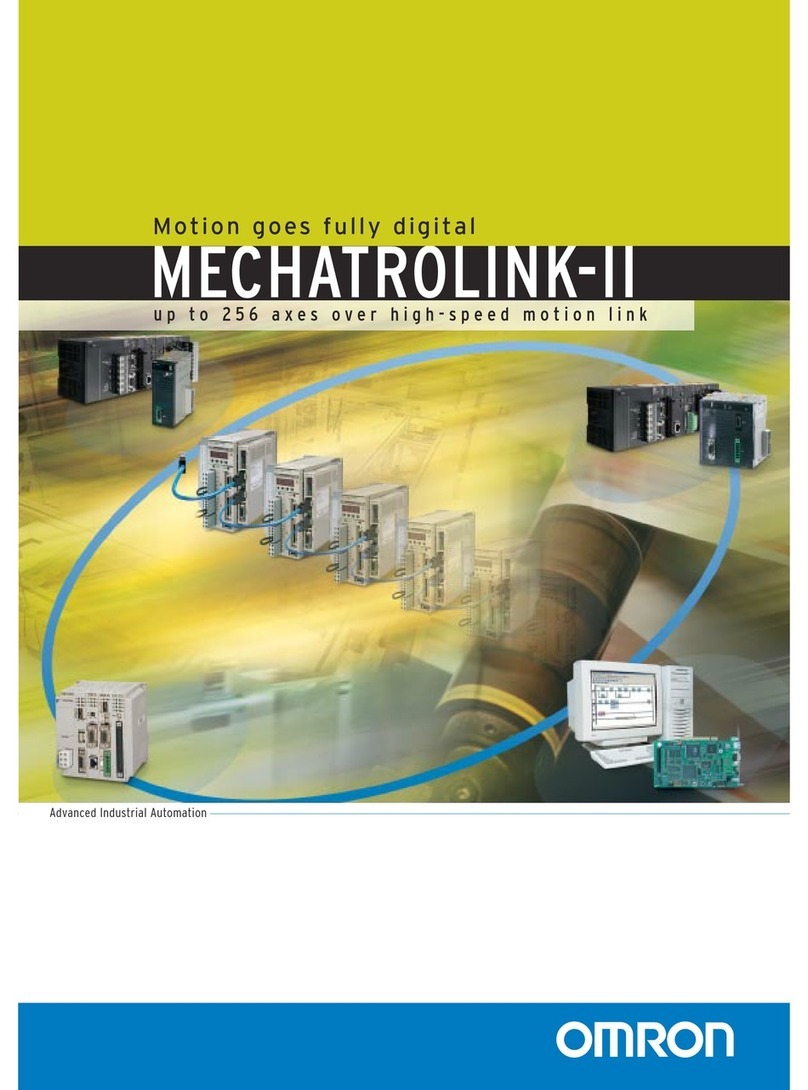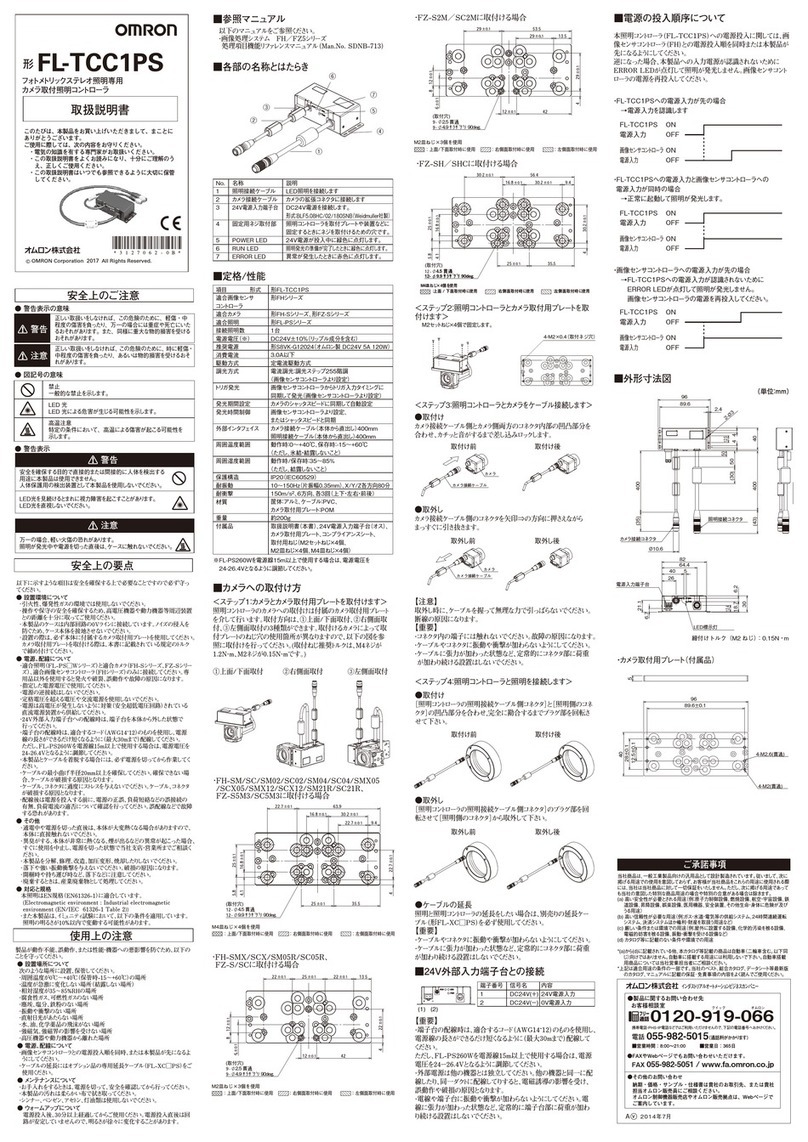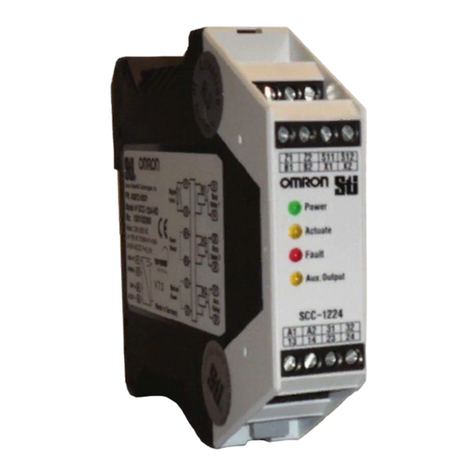
• Confirm that no adverse effect will occur in the system before attempting any of the fol-
lowing. Not doing so may result in an unexpected operation.
• Changing the operating mode of the PLC.
• Force–setting/force–resetting any bit in memory.
• Changing the present value of any word or any set value in memory.
• Do not turn OFF the Unit’s power supply while transferring or backing up data. Time is
required particularly to back up data. Do not turn OFF the power while the BKUP indicator
is lit. The data will not be backed up if power is turned OFF.
• Before turning OFF the power supply, confirm that the Units will start in the appropriate
operating modes the next time the power supply is turned ON.
• Resume operation only after transferring to the new CPU Unit and/or Special I/O Units the
contents of the DM and HR Areas required for resuming operation. Not doing so may re-
sult in an unexpected operation.
• Do not pull on the cables or bend the cables beyond their natural limit. Doing either of
these may break the cables.
• Do not place objects on the cables. Doing so may break the cables.
• Use the dedicated connecting cables specified in operation manuals to connect the Units.
Using commercially available RS–232C computer cables may cause failures in external
devices or the CPU Unit.
• Do not connect pin 6 (+5V) on the RS–232C port on the CPU Unit to any external device
other than the NT–AL001 or CJ1W–CIF01 Conversion Adapter. The external device and
the CPU Unit may be damaged.
• Do not turn OFF the power supply to the PLC or remove the Memory Card while the
Memory Card is being accessed. Before removing a Memory Card, press the button to
stop power supply to the Memory Card and wait for the BUSY indicator to go out.
• When replacing parts, be sure to confirm that the rating of a new part is correct. Not doing
so may result in malfunction or burning.
• When replacing the battery for a Unit, be sure to follow the procedure described in that
Unit’s operation manual.
• Dispose of the product and batteries according to local ordinances as they apply.
Have qualified specialists properly dispose of used batteries as industrial waste.
Dispose of in accordance
with WEEE Directive.
•Before touching the Unit, be sure to first touch a grounded metallic object in order to
discharge any static built–up. Not doing so may result in malfunction or damage.
• Do not turn OFF the power supply to the Unit while data is being transferred.
• When transporting or storing the product, cover the PCBs with electrically conductive
materials to prevent LSIs and ICs from being damaged by static electricity, and also keep
the product within the specified storage temperature range.
• Do not touch the mounted parts or the rear surface of PCBs because PCBs have sharp
edges such as electrical leads.
• Double–check the pin numbers when assembling and wiring the connectors.
• Wire correctly according to specified procedures.
• The operation mode upon turning the power ON varies depending on the model. Refer to
the user manual for details.
• Do not mount a C200HW–PA/PD@@@ Power Supply Unit to a CS1D–BC/BI@@@ Back-
plane. Otherwise the system will stop.
•Do not mount a CS1D–PA/PD@@@ Power Supply Unit to any Backplane other than a
CS1D–BC/BI@@@ Backplane. Otherwise faulty operation or burning will occur.
•In a CS1D Duplex-CPU Duplex System, always mount CS1D-CPU@@HA/P/H Du-
plex-CPU System CPU Units to the CS1D-BC052 or CS1D-BC042D CPU Backplane.
Faulty operation will occur if any other CPU Unit is mounted.
•In a CS1D Single–CPU Duplex System, always mount a CS1D–CPU@@SA/S Single–CPU
System CPU Unit to the CS1D–BC82S CPU Backplane. Faulty operation will occur if any
other CPU Unit is mounted.
•Do not mount a CS1D-CPU@@HA/SA/P/H/S CPU Unit to a CS1W-BC@@@ (non-CS1D)
CPU Backplane. Otherwise, faulty operation will occur.
•Always confirm that connected external devices are not operating before performing
online replacement of Units. Not doing so may result in faulty outputs and unexpected
operation in the device or controlled system.
•Follow the procedure in the Operation Manual when performing online replacement of
Units.
•When performing online replacement of a Unit, always replace the Unit with one with the
same specifications.
•Check that data link tables and parameters are properly set before starting operation. Not
doing so may result in unexpected operation. Even if the tables and parameters are
properly set, confirm that no adverse effects will occur in the system before running or
stopping data links.
•Transfer a routing table to the CPU Unit only after confirming that no adverse effects will
be caused by restarting CPU Bus Units, which is automatically done to make the new ta-
bles effective.
•Always use the following size wire when connecting I/O Units, Special I/O Units, and CPU
Bus Units: AWG22 to AWG18 (0.32 to 0.82 mm2).
•When removing a Unit during operation without a PLC Programming Device
(CX–Programmer or a Programming Console), always confirm that the PLC Setup is set
to enable the function for Unit removal without a Programming Device or the function for
Unit removal and mounting without a Programming Device. If a Unit is removed while the
PLC Setup is not set to allow Unit removal without a Programming Device, an I/O bus er-
ror will occur and the PLC (CPU Unit) will stop operating.
•When a Unit has been removed during operation without a PLC Programming Device
(CX-Programmer or a Programming Console), data transferred from the removed Unit to
the CPU Unit may be invalid. If an invalid data transfer will adversely affect the system,
use a Programming Device to replace the Unit online.
•When the function for Unit removal without a Programming Device or the function for Unit
removal and mounting without a Programming Device is enabled in the PLC Setup and a
Special I/O Unit has been removed, the Special I/O Unit Area words allocated to that Unit
for data transfer (to and from the CPU Unit) will be cleared. If the loss of the Special I/O
Unit Area data will adversely affect the system, disable both of these functions in the PLC
Setup and use a Programming Device to replace the Unit online. (If a Programming De-
vice is used to replace the Unit online, the data in the Special I/O Unit Area will be re-
tained while the Unit is removed.)
•An I/O bus error, which can be caused by a Unit malfunction, is normally a fatal error that
stops operation. When the function for Unit removal without a Programming Device or the
function for Unit removal and mounting without a Programming Device is enabled in the
PLC Setup, the I/O bus error will be treated as a non–fatal error and the PLC (CPU Unit)
will not stop operating. If there are any Units that will adversely affect the system if an I/O
bus error occurs, do not enable either of these functions in the PLC Setup.
•Do not turn ON the Maintenance Start Bit (A80015) continuously from the ladder program.
As long as the Maintenance Start Bit is ON, errors will not be generated even if there are
Unit malfunctions, so the system may be adversely affected.
Note: The Maintenance Start Bit is provided to prevent non-fatal errors from occurring
during Unit removal without a Programming Device.
•Do not turn ON the Online Replacement Completed Bit (A80215) continuously from the
ladder program. If the Unit is mounted while the Online Replacement Completed Bit is ON,
the PLC (CPU Unit) may stop operating.
Note: The Online Replacement Completed Bit is provided to restart data exchange be-
tween a replaced Unit and the CPU Unit. After a Unit has been replaced without a Pro-
gramming Device, turn ON the Online Replacement Completed Bit to restart data ex-
change.
•Always turn OFF the reserved pin (RSV) of the Duplex Unit’s Communications Setting
DIP Switch.
•When replacing the Duplex Unit online in a Duplex-CPU Dual-I/O-Expansion System,
always use the procedure given in the manual.
•When replacing an Expansion Unit or Expansion Cable online in a Duplex-CPU Du-
al-I/O-Expansion System, always use the procedure given in the manual.
•When using duplex Expansion Cables in a Duplex-CPU Dual-I/O-Expansion System,
always use Expansion Cables of the same length.
•In a Duplex-CPU Dual-I/O-Expansion System, do not connect two Expansion Cables to
different series of Expansion Backplanes. Malfunction may occur.
Reference Manuals
Please be sure to read the related user manuals in order to use the PLC safely and properly. Be sure you are using the most current version of the manual.
Name Cat No.
CS–series CS1G/H–CPU@@H, CS1G/H–CPU@@–EV1 Programmable Controllers
Operation Manual W339
CS–series CS1D–CPU@@HA/SA/P/H/S CS1D Duplex System Operation Manual W405
CS/CJ–series CS1G/H–CPU@@H, CS1G/H–CPU@@–EV1, CJ1G–CPU@@,
CJ1G/H–CPU@@H Programmable Controllers Programming Manual W394
CS/CJ–series CS1G/H–CPU@@H, CS1G/H–CPU@@–EV1, CJ1G–CPU@@,
CJ1G/H–CPU@@H Programmable Controllers Instructions Reference Manual W474
CS/CJ–series CS1G/H–CPU@@H, CS1G/H–CPU@@–EV1, CJ1G–CPU@@,
CJ1G/H–CPU@@H Programmable Controllers Communications Commands Refer-
ence Manual
W342
CS1W–SCB@1(–V1), CS1W–SCU@1(–V1) Operation Manual W336
CS1W–ETN21 Ethernet Unit (100Base–TX Type) CS1W–ETN21 Operation Manual
Construction of Networks W420
CS1W–ETN21 Ethernet Unit (100Base–TX Type) CS1W–ETN21 Operation Manual
Construction of Applications W421
CS1D–ETN21D Ethernet Unit Operation Manual W430
CS1W–FLN22/CJ1W–FLN22 FL–net Unit (100BASE–TX) Operation Manual W440
CS1W–DRM21(–V1) DeviceNet Unit Operation Manual W380
DeviceNet Operation Manual W267
CS1W-CLK23, CS1W–CLK21–V1 (wired) Controller Link Units,
CS1W–RPT01/02/03 Repeater Units Operation Manual W309
CS1W-CLK13 (Optical Ring H–PCF Type)
CS1W-CLK53 (Optical Ring GI Type)
CVM1–CLK12/CS1W–CLK12(–V1) (Optical Ring H–PCF Type)
CVM1–CLK52/CS1W–CLK52(–V1) (Optical Ring GI Type) Controller Link Units
Operation Manual
W370
CS1W–HIO01/HCP22/HCA22 Customizable Counter Units Operation Manual W378
CS1W–HIO01/HCP22/HCA22 Customizable Counter Units Programming Manual W384
CS1W–LCB01/05 Loop Control Boards, CS1D–CPU@@ Process–control CPU
Units, CJ1G–CPU@@P Loop–control CPU Units Operation Manual W406
CS1W–LCB01/05 Loop Control Boards, CS1D–CPU@@PProcess–control CPU
Units, CJ1G–CPU@@P Loop–control CPU Units Function Block Reference Manual W407
WS02–LCTC1–E CX–Process Tool Operation Manual W372
WS02–LCTC1–E CX–Process Monitor Operation Manual W373
WS02–LCMC1–E CX–Process Monitor Plus Operation Manual W428
CS1W–PTS@@/PTW01/PDC@@/PTR@@/PPS01/PMV@@/CJ1W–PTS@@ Analog I/O
Units Operation Manual W368
CS1W–AD041(–V1)/081(–V1), CS1W–DA041/08V/08C, CS1W–MAD44,
CJ1W–AD041–V1/081(–V1), CJ1W–DA021/041/08V, CJ1W–MAD42 Analog I/O
Units Operation Manual
W345
CS1W–CT021/041 High–speed Counter Units Operation Manual W902
CS1W–MC421(–V1)/221(–V1) Motion Control Unit Operation Manual W359
SYSMAC CXONE–AL@@C–E CX–One FA Integrated Tool Package Setup Manual W444
Name Cat No.
Name Cat No.
CS/CJ–series CQM1H–PRO01–E/CQM1–PRO01–E/C200H–PRO27–E Program-
ming Consoles Operation Manual W341
CS1W–SPU01/02 Storage & Processing Unit User’s Manual V229
CS1W–SPU01/02 Storage & Processing Unit Operation Manual V230
SUITABILITY FOR USE
Omron Companies shall not be responsible for conformity with any standards, codes or
regulations which apply to the combination of the Product in the Buyer’s application or
use of the Product. At Buyer’s request, Omron will provide applicable third party certi-
fication documents identifying ratings and limitations of use which apply to the Product.
This information by itself is not sufficient for a complete determination of the suitability
of the Product in combination with the end product, machine, system, or other applica-
tion or use. Buyer shall be solely responsible for determining appropriateness of the
particular Product with respect to Buyer’s application, product or system. Buyer shall
take application responsibility in all cases.
NEVER USE THE PRODUCT FOR AN APPLICATION INVOLVING SERIOUS RISK
TO LIFE OR PROPERTY OR IN LARGE QUANTITIES WITHOUT ENSURING THAT
THE SYSTEM AS A WHOLE HAS BEEN DESIGNED TO ADDRESS THE RISKS,
AND THAT THE OMRON PRODUCT(S) IS PROPERLY RATED AND INSTALLED
FOR THE INTENDED USE WITHIN THE OVERALL EQUIPMENT OR SYSTEM.
